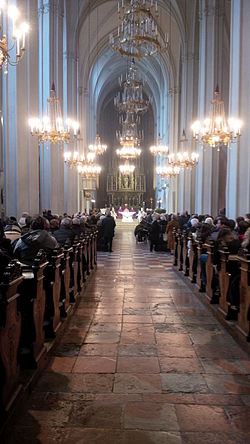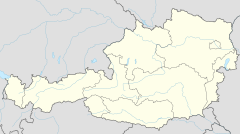Augustinian Church, Vienna
| Augustinerkirche | ||
|---|---|---|
Year consecrated 1349 | | |
| Location | ||
| Location | Vienna, Austria | |
| State | Vienna | |
| Geographic coordinates | 48°12′21″N 16°22′02″E / 48.205722°N 16.367222°E | |
| Architecture | ||
| Architect(s) | Dietrich Landtner | |
| Type | Church | |
| Style | Gothic, Baroque | |
| Groundbreaking | 1327 | |
| Completed | 1339 | |
| Specifications | ||
| Direction of façade | NW | |
| Length | 85 m (278.9 ft) | |
| Width | 20 m (65.6 ft) | |
| Width (nave) | 11 m (36.1 ft) | |
| Website | ||
| www | ||
The Augustinian Church (German: Augustinerkirche) in
History
In 1327, Duke
In 1634, the Augustinerkirche became the parish church of the imperial church and so many
A functioning monastery of six black-robed Augustinian monks remains and serves the needs of the parish.
Exterior

The Gothic church is 85 m (278.9 ft) long and 20 m (65.6 ft) wide. The nave is 11 m (36.1 ft) wide.[2]
Interior
The
The pulpit was designed by Hofarchitekt Johann Ferdinand Hetzendorf von Hohenberg in 1784/85. when the church was returned to its original Gothic style.[3] It is an early example of Gothic Revivalism in Central Europe. The white-and-gold wooden structure is placed on a column with a foliated Gothic capital. The balustrade and the rear wall is decorated with simple blind tracery. The abat-voix forms a canopy with the usual symbol of the dove and a statue of Saint Paul (?) on the top. A painting of the interior by Martin van Meytens from 1760 shows another simple, rectangular pulpit with the statue of the Madonna on the top.
Chapels
The Loreto Chapel, to the right of the main altar, holds the silver urns containing the hearts of
Cenotaph of Maria Christina
Notable among the church's monuments is the memorial to
Sacred music
Composer Franz Schubert conducted his Mass in F major there, and Anton Bruckner's Mass in F minor was written for the church and was first performed there. In the 21st century, the church is known to host high quality sacred music concerts, particularly for its weekly Sunday High mass with full orchestra and choir. The church has two organs.
Gallery
-
Interior
-
Altar
-
Rieger Organ
-
Bach Organ
-
Chandeliers
-
Side altar with painting of Emperor Karl I
-
The pulpit
Cenotaph for Archduchess Maria Christina
References
- Citations
- ^ "Augustinerkirche". Wein-Vienna. Archived from the original on 5 February 2013. Retrieved 29 January 2013.
- ^ Estimated specifications from satellite images provided by Google Earth
- ^ Felix Czeike: Wien. Kunst, Kultur und Geschichte der Donaumetropole, DuMont Reiseverlag, 1999, p. 120
- ^ "Die Herzgruft in der Loretokapelle" (in German). Augustinerkloster. Archived from the original on 5 February 2012. Retrieved 11 December 2007.
- Bibliography
- Brook, Stephan (2012). DK Eyewitness Travel Guide: Vienna. London: Dorling Kindersley Ltd. ISBN 978-0756684280.
- Gaillemin, Jean-Louis (1994). Knopf Guides: Vienna. New York: Alfred A. Knopf. ISBN 978-0679750680.
- Meth-Cohn, Delia (1993). Vienna: Art and History. Florence: Summerfield Press. ASIN B000NQLZ5K.
- Schnorr, Lina (2012). Imperial Vienna. Vienna: HB Medienvertrieb GesmbH. ISBN 978-3950239690.
- Schulte-Peevers, Andrea (2007). Alison Coupe (ed.). Michelin Green Guide Austria. London: Michelin Travel & Lifestyle. ISBN 978-2067123250.
- Toman, Rolf (1999). Vienna: Art and Architecture. Cologne: Könemann. ISBN 978-3829020442.
External links
- "Geschichte der Kirche St.Augustin" (in German). Augustinerkloster. Archived from the original on 23 July 2007. Retrieved 11 December 2007.
- "Die Herzgruft in der Loretokapelle" (in German). Augustinerkloster. Archived from the original on 5 February 2012. Retrieved 11 December 2007.
- Official website















